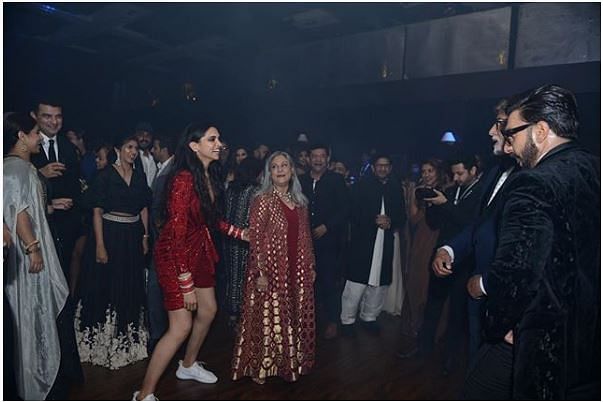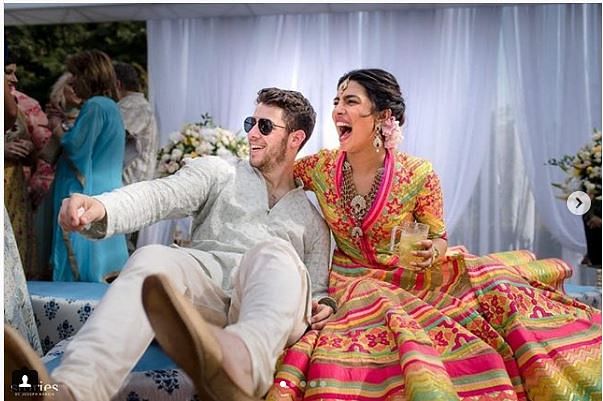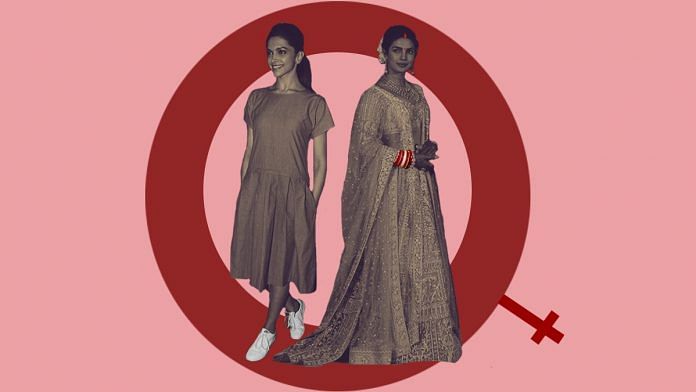From Sonam Kapoor to Priyanka Chopra, there is an almost gleeful and defiant embrace of hyper-ritualistic ostentations.
There is a moment captured on camera, not accidentally, where Deepika Padukone has hitched up her Zuhair Murad dress, put on her sneakers, for what seems to be a dance-off between the “boys and girls” at her third wedding reception.
Like everything in the four big Bollywood weddings in the last one year (Anushka Sharma, Sonam Kapoor, Deepika Padukone and Priyanka Chopra), it has been carefully choreographed. We are meant to applaud the bride’s delight in marrying the man of her choice, on her own terms, as so graciously admitted by the groom himself who told Filmfare magazine that “I’ve been ready (to get married) for a while. I was just waiting for Deepika to be ready”.
But we are also drawn to other aspects of the photograph: the bride’s sneakers, inspired no doubt by countless, closely watched re-runs of Julia Roberts’ Runaway Bride; the sindoor and the chooda worn seemingly inappropriately with a couture gown; and the invisible labels hanging from the clothes worn by everyone in the frame.

Also read: Priyanka Chopra promotes feminist app Bumble while wearing thick sindoor and choodas
Those three things say so much about the A-list weddings of the year in which four women at the top of their game have “taken the power back” to quote Priyanka Chopra’s words in an unrelated context. All four have joined the global trend of power weddings that blend the business of feminism with “leaning in”. Each wedding has seemed cinematic, clearly borrowed in some way or the other from various movies, topped by Hum Aapke Hain Kaun, the 1994 blockbuster that kicked off the whole idea of weddings being “the most visible site of conspicuous consumption and conspicuous waste” to quote sociologist Patricia Uberoi.
The Sooraj Barjatya film was the first movie post liberalisation to understand the new “moral consumer”, one who was as at home with modernity as with tradition, who celebrated the detailed rituals involved in weddings and participated in all of them with enthusiasm (much like the reported sangeet competition between the Chopras and the Jonases in Jodhpur), and was equally at ease with the idea of a dutiful yet playful young woman who had studied “computers”.
The other point is the very obvious visual stamp of being married, popularised by Ekta Kapoor’s serials at the beginning of the noughties. The sindoor, the chooda, the mangalsutra, these were all accoutrements women of the previous generation spent many years trying to avoid wearing.
But in all the brides, from Sonam Kapoor to Priyanka Chopra, there is an almost gleeful and defiant embrace of these hyper-ritualistic ostentations. This underlines the careful blending of cultures that each wedding was – whether it was foreign destinations and Konkani- Sindhi rituals for Padukone or a 75-foot veil and a Ralph Lauren wedding dress in Jodhpur for Chopra. The message from both is clear – here are two stars from India who have headlined two very American entertainment projects, Quantico for Chopra and xXx: Return of Xander Cage for Padukone, who are equally at ease with Indian and Western traditions.

Also read: Deepika Padukone’s hearty laughter at her wedding has shattered an age-old culture
There is an idea being sold to the women in India. You can be a feminist even when you’re weighed down in 20 kg designer lehengas that can feed a family for a year. You can be a boss lady even when you’re wearing sindoor talking up a social networking company you’ve invested in to a bunch of journalists and socialites while casually draping your husband’s jacket over your shoulders as he watches mostly in bemused silence, playing his part perfectly as the smitten kitten in a reversal of roles. And, you can be a complete diva days after your massive #everydayphenomenal wedding by taking yourself off to a working honeymoon in Cannes, doing all the hair tossing and dress twirling demanded by your global sponsor at the Palais des Festivals red carpet.
As Mumbai cinema discovered this year in countless movies, from Stree to Badhaai Ho, making feminist films is good business. Indian cinema halls may still be underserving the market, but they are changing to accommodate specialist audiences, not always led by the man in the family.
The Government of India is not the only one that has discovered that slogans like Beti Padhao Beti Bachao are more about promise, positioning and posturing than actual delivery. Mumbai movies have long since ceased to marvel at the irony of Queen, the small-town woman’s anthem of independence, being directed by a man accused by his former assistant of sexual harassment.
A certain kind of feminism is emerging in India, which sociologist Maitrayee Chaudhuri calls “pre-fab feminism”, referring to a shopping-friendly, market-enabled idea of what empowerment has become. This shows the woman belonging both to the world and at home, at ease in the corner office and equally comfortable cooking at home. It’s called “having it all” and “leaning in” and by now, even its fiercest proponent Sheryl Sandberg stands stripped of her aura since stories have surfaced about how much she actually knew of Russian manipulation of Facebook.
Also read: After Deepika-Ranveer, Priyanka Chopra and Nick Jonas are in control of their wedding story
But India is always a little late to the global zeitgeist so we can be forgiven for selling this dream a little while longer. After all, Priyanka Chopra is living proof that you can reconstruct yourself to fit into another culture, even if it takes six years, relentless duets with American singers, the Thursday night NFL slot, the role of a suspected terrorist in an ABC soap and fun games with late night television hosts. It’s tough – Aishwarya Rai Bachchan tried to do that as well, with a then-hot Gurinder Chadha’s Bride and Prejudice and spots on shows like David Letterman’s but she had neither the temperament nor the tenacity to face a series of initial rejections.
Perhaps these stars have the answer to every young woman’s ambition – play the game according to the rules set by the men but make sure your favourite charity gets paid by Amazon, your jewellery comes from Chopard and Tiffany, your clothes come from a series of designers who are willing to embellish and embroider to your heart’s desire, your magazine covers come from Vogue (US edition, mind you, we’re told by her celebrity manager, and People) and your husband gets his Elit vodka and electric scooters too. And in a male-dominated entertainment industry, you get top billing. So what if people can’t tell the difference between the latest Manyavar ad and the actual wedding.
The author is a senior journalist and was Editor of India Today between 2011 and 2014




For kind your information before talking about ambedkar you have read “Rangila Gandhi” book
Ese padh lo jaan jayoge…
Do you walk the talk Kaveree ji? You talk feminism when it comes to stars but are you supportive of the same in office and with colleagues? ‘Coz nowadays big names like you do a double speak.
Gandhi has always maintained double standards about the freedom of untouchables,a firm believer of Varnashram .
Jealous much?
whats the point of this long, boring, meandering article?